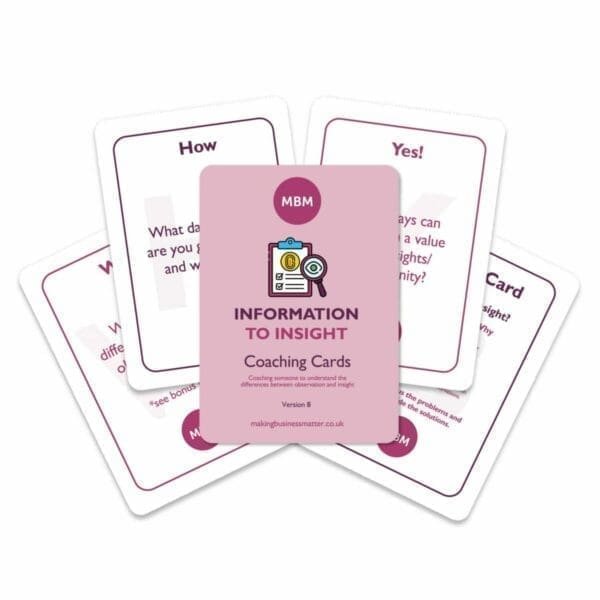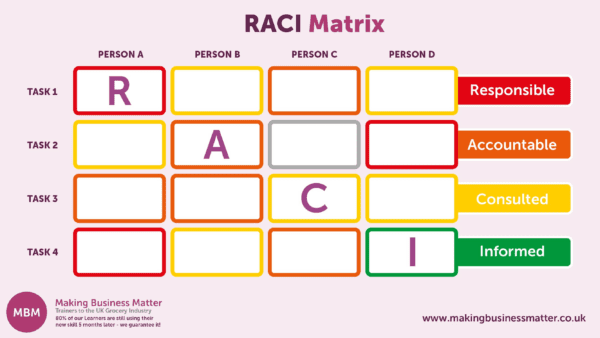So, You’re Interested in the RACI Matrix?
You may not have heard of the RACI Matrix, or you may have learned some but want to know more. As a leader, you ensure that the team cover every aspect of the project or task at hand. Here, the RACI matrix helps you get that done in a more efficient way. But, how does it work? And, what are the advantages and limitations of using such a tool? Worry not, we’re here to help you understand this useful tool better.
So, let’s answer all your frequently asked questions.
What is the RACI Matrix? (What Does the Acronym RACI Stand for?)
The RACI matrix is a responsibility matrix, also known as the ARCI matrix. It is a model that describes the participation of different people to complete tasks and deliverables for a project or business process. Thus, its aim is to solve the lack of clarity of who does what in projects.
RACI is pronounced ‘ray-see’. It was originally called the ‘Decision Rights Matrix’ since it was developed in the 1950s. We use this business process for meetings, onboarding and, large tasks. However, we associate it generally with project management. The advantages include increased teamwork, collaboration and communication, creating a simple language to discuss roles and responsibilities in an organisation.
Additionally, the RACI Matrix is known as the ‘Responsibility Assignment Matrix.’

>> Information to Insight Coaching Cards <<
>> Access on Amazon <<
What are the 4 Components of the RACI Matrix? (RACI Definition)
The 4 Components of the RACI Matrix are:
- Responsible
- Accountable
- Consulted
- Informed

Sticky Learning ® is 7 times more effective than 1-day training courses. Plus, you will get a Chain of Evidence proving your Return on Investment. Discover soft skills training that changes behaviours long term.

The First Two are Swapped for the ARCI Matrix:
- Accountable
- Responsible
- Consulted
- Informed
Although known as the RACI Matrix, ARCI makes more sense to me than RACI, because the ‘importance’ descends in order. Below, each letter represents the 4 responsibilities. We define those responsibilities as:
1. Accountable – The ‘Buck Stops with You’.
First, you call this person the owner. This is one person and only one person. They ensure that the outcome/objectives of the project or task happen. Therefore, for decisions involving resources, budgets and ‘big’ decisions, the ‘Accountable’ has the final say.
2. Responsible – The ‘Doers’.
Next, these people actually do the required tasks or project work. They make it happen. Consequently, the workload largely falls to them. Here, we have one doer for every task or area. Avoid assigning more than one without clear instructions and directions. Otherwise, you have confusion and overlapping.
3. Consulted – ‘The Experts’.
Then, these people share their relevant experience and knowledge to support the project. This is two-way communication. Consultants provide information that the doers do not have. Then, the doers use this information to get to work.
4. Informed – ‘Those in the Loop’.
Finally, colleagues, and people kept updated on the progress of the project. Here, we use one-way communication. Basically, we tell them what’s going on. So, we keep those that need to know what is happening in the loop and updated. Typically, these are the project stakeholders.
The ARCI People and Words Used to Describe Them are:

- Accountable: Owner, Project Sponsor, or Project Leader.
- Responsible: Doers, Operators, or the people that actually make it happen.
- Consulted: Assists, Experts, Subject Matter Experts, or Communicated with.
- Informed: Stakeholder, Communicated to, or In-the-know.
What are the Advantages of Using the Responsibility Matrix?
There are many advantages of using the RACI matrix. Here are some.
Firstly, communication is much more streamlined. Here, involve the right people at the right time in the right decisions and tasks. Therefore, the matrix prevents people crossing ‘swim lanes’ when they don’t need to. Instead, we stay in the areas allocated to us.
Also, we request suggestions and ideas as required from specific people. We avoid having input from everyone. So, you don’t have “too many cooks”. Therefore, aim for the right opinions on the right things from the necessary people. This way, we manage our time better. Also, meetings and project updates stay on topic.
Finally, there is less silo working and better collaboration. Here, there are clear expectations of what is required. Working together, the roles and the project are clearer.
What are the Pitfalls and How Do You Avoid Them?
Like any tool in our toolkit, there are some disadvantages of the RACI matrix. Let’s see some of those possible pitfalls now.
Fist, using the ARCI model and not knowing how to use it effectively can prove more troublesome than it is worth. Therefore, understand the model with good research before attempting to use it. Also, avoid skipping important steps along the way. Otherwise, your model will have gaps that lead to tasks incomplete.
Next, the preparation is essential. Don’t rush just because everyone just wants to ‘get on with it’. Instead, prepare well to save time later. Plan your allocations carefully after proper analysis and consideration.
The “Accountable” person must know exactly what is expected of them. Yes, it sounds good to be the ‘boss’ of the project but it comes with expectations around decision making and being able to see the bigger picture. Therefore, assign the Accountable role carefully. Understand the strengths and limitations of the person before throwing them into that position. Also, have open, frank conversations with them about the expected outcome and expectations. The Project Manager, or Team Leader, is normally the person that is accountable. They don’t do all the work. That’s not their role. Instead, they make sure that it happens.
Finally, people resent not having a say. Here, they don’t have a voice. Also, decisions are made without their input. Therefore, it is important that the right people are put into the right groups. Communicate effectively with the “Informed” group to avoid resistance or negativity towards a project or task.
Hence, not useful for small projects.

How Do You Use a RACI Chart?
Now, let’s take an at-home and simple project before we move on to a business project:
#1- Having a Party at Home
- Mum: She is Accountable for the project objective and this involves all the guests arriving on time, having a great time, and within the budget agreed.
- Dad: He is Responsible for organising the car parking, who is sleeping-over and how, games on the night, and managing the budget.
- Daughter: She is Responsible for sending the invitations, buying the decorations, and organising the music.
- Son: He is Responsible for writing a list of food and drink needed, shopping, and preparing and cooking the dinner.
- Neighbours: We consult them about the noise. We even consulted them about attending the event. Additionally, discuss a possible catering option with caterers, and a possible DJ.
- Guests: Simply, we keep them Informed. Here, we share information about date, time, venue, etc.
#2- Implementing a Customer Relationship Management (CRM) Tool
- Accountable – Sales Director: The Sales Director ensures that the tool works as per the company’s needs, within budget and timescale.
- Responsible – Sales Manager: They implement the tool and ensure that everyone is trained.
- Consulted – CRM Provider: The CRM Provider provides options that meet the objectives.
- Informed – Production: They know that the system is being implemented when it is being implemented, and what it means for production.
#3- Use RACI Matrix in HR
This tool is not limited to projects. In fact, I have personally used this for HR related processes. Let me explain how that works.
HR sees a lot of changes and processes that need proper structure and clarity. Therefore, this tool works well for those purposes. Here, let’s look at the process used for onboarding a new hire.
- Accountable – HR Director/Manager: ultimately, they oversee the whole process. They ensure that all new hires join the team effectively.
- Responsible – Direct Report: they ensure the programme is followed for proper induction of the new team member.
- Consulted – Team Leaders: their input is necessary for the programme to be established. Ensure they agree to the allocated dates and times for the orientation.
- Informed – The New Hire: keep them updated on the programme they follow throughout the onboarding process.
Five Steps to Creating RACI Matrix for a Project

1. Identify your SMART project objectives.
First, understand the goals and objectives of the project or business process. This is the important first stepping stone of the entire exercise. Goals state the “big picture” outcomes to be achieved. Objectives clarify the specific steps to be taken to achieve those bigger goals. Therefore, create SMART (Specific, Measured, Achievable, Realistic/Relevant, Time-bound) objectives that the team use to get the job done.
2. Get sign-off of the project objectives with the Accountable person.
Next, ensure you have the proper approval to move forward with the project or business process. Don’t move forward without this. Otherwise, you waste time, effort and energy. Instead, prepare everything that is required. Then, get the sign-off to proceed. Only then start moving forward with the team.
3. List all the tasks that are needed to achieve the project objectives.
Include everything. Leave nothing out. That way, there are no gaps moving forward. Here, confirm every step needed and assign everything carefully. So, cover all of your bases for better results moving forward.
4. List all the people that you need to achieve the project objectives.
Ensure everyone has areas assigned to them. However, avoid overloading people with too many responsibilities. Otherwise, you cause burnout through stress. Instead, assign the tasks as evenly as possible. However, always assign tasks to peoples’ strengths. The results are better that way.
5. State what each person’s role is for each task.
Communication is key. Therefore, hold meetings to discuss roles and responsibilities with the teams. Also, have 1-1 conversations to create clarity. Avoid confusion, and have a clear picture for everyone involved.
What are the RACI Rules? (Can there be 2 Accountable in RACI?)
- Only one person is Accountable so decisions are not by committee, but quickly.
- Only one person is Responsible per action/task, to avoid ‘I thought you were doing it’.
- Consulted is two-way communication.
- Informed is one-way communication.
- Make sure the objectives or targets are SMART.
- Take action at each meeting with a simple ‘who, what, & when”, and distribute within an hour of the meeting ending.
- Have shorter & more frequent meetings rather than longer & less frequent ones because people typically do their actions just before or just after a meeting.
Can R and A be the Same in RACI?
Yes. Sometimes R and A are the same person. Often, on larger projects, it is because the person that is accountable needs to take a more strategic perspective on the project, rather than being ‘in the thick of it’ – not able to see the wood for the trees.
What are Variations of the RACI Matrix?
There have been many variations of this model since it was created in the 1950s. For example, RACI is used in conjunction with Agile by adding an ‘F’ for Facilitator. Below are 16 other variations of the RACI model:

- RASCI: Responsible, Accountable, Supportive, Consulted, and Informed.
- DRASCI: Similar to RASCI but has a ‘D-Driver’ who centrally delegates the responsibilities.
- RATSI: Responsibility, Authority, Task, Support, and Informed. Again, similar to RASCI, which highlights the actual ‘T-Task’ performers.
- ARCI: Accountable, Responsible, Consulted, and Informed.
- RAS: Responsible, Approve and Support.
- CLAM: Contributes, Leads, Approves, and Monitors.
- PACSI: Perform, Accountable, Control, Suggest, and Informed.
- RACIQ: Responsible, Accountable, Consulted, Informed, and Quality Review.
- RACI-VS: Responsible, Accountable, Consulted, Informed, Verifier, and Signatory.
- CAIRO: Consulted, Accountable, Informed, Responsible, and Omitted.
- DACI: Driver, Approver, Contributors, and Informed. Replacing ‘D-Driver’ with ‘R-Responsible” in RACI.
- RAPID: Recommendation, Agreement, Perform, Inputs, and Decisions.
- PDQA: Primary, Decision, Quality, and Assist.
- RASCEIO: Responsible, Accountable, Support, Consult, Execute, Inform, and Overview.
- PARIS: Participant, Accountable, Review, Input, and Sign-Off.
- CARS: Communicate, Approve, Responsible, and Support.
Wrap Up
So there you have it. As you can see, the RACI matrix gives leaders a useful tool for effective task and responsibility distribution. Before we finish, look at the below final recap for effective use of this tool.
- Use clear templates for the RACI matrix. Create ease for the team by developing an easy-to-use format.
- Apply this tool in different projects and business processes to achieve better results.
- Avoid overloading people with too many responsibilities.
- Analyse the strengths of your team members for better allocation of responsibilities.
- Create clarity and understanding for everyone involved with effective communication skills.
- Ensure you match the right people to the correct roles for best results.
- And be ready to make changes if your objectives are not being met.
Finally, we hope you enjoyed the article and are ready to get the RACI matrix working for you.
Updated: October 2023 by Ailish O’Rourke-Henriette




